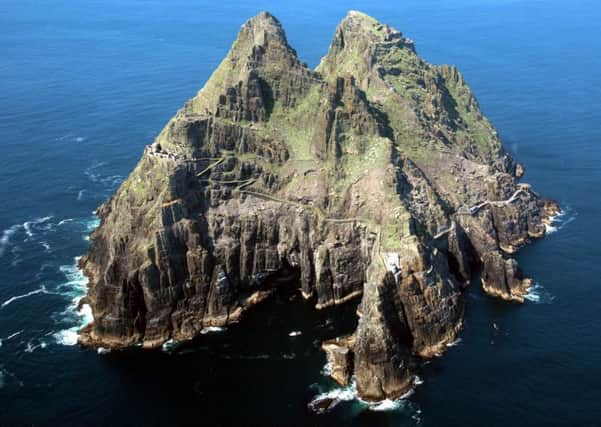Travel review: Skellig Michael - the home of the Last Jedi


I’m bouncing around our fishing boat with unbridled glee as we steer towards the Skellig Islands off the west coast of Ireland.
Christian monks inhabited the islands for 500 years a millennium ago, but it was the arrival of the Millennium Falcon last year, in Star Wars: The Force Awakens, that has shot the small rocky outcrops into international stardom.
Advertisement
Hide AdAdvertisement
Hide AdI do wonder what the monks of the Middle Ages would make of the sudden influx of Star Wars tourists, and the fact their monastery will feature as a Jedi outpost for Luke Skywalker in the eighth Star Wars instalment, The Last Jedi.
Approaching Skellig Michael, the larger of the two islands, is a magical journey. There are loud squawks as we pull into the dock, and puffins zip past my ears as I wander along a cliff path to the foot of the ancient walkway.
Only 13 boats are licensed to make the journey to Skellig Michael, but they won’t dock if the water is too rough. Thankfully, the Force is on my side and I’m one of the lucky 114 visitors allowed to walk on the protected island on the day of my visit. But we’re still outnumbered by puffins.
They are everywhere, poking their heads out of every nook and cranny along the hillside.
Advertisement
Hide AdAdvertisement
Hide AdThey’re not used to human contact, and so appear fearless as I creep closer for a photo. They do, however, look extremely nervous when considering a flight.
They are the complete opposite of the gannets and petrels who also inhabit the island and soar majestically through the air above. Using the slate steps as little runways, the puffins waddle towards the edge, their sad expressions silently asking: “Do I really have to do this?”
Those returning to the island land with a thud, and then waddle towards their nests to answer the call of their chicks – an eerie ‘moo’ that sounds like a combination of a wounded cow and a lost sheep.
I head up the slated steps, as Rey did on her journey to meet Luke, until I reach the island’s cradle.
Advertisement
Hide AdAdvertisement
Hide AdI take a few minutes to soak up the splendid views out to Little Skellig and Co Kerry, posing on the spot with a lightsaber and Yoda toy that someone has thoughtfully brought with them. Most people appear to be content with the cradle, but my journey is only half complete, so I continue to the 1000-year-old monastery, leaving others behind. The monks who built this believed it was at the end of the earth.
I explore the six stone huts and small cemetery with childish enthusiasm.
Daisy Ridley (Rey) was sick for most of her time filming for The Force Awakens, my hotelier, Gerard Kennedy, tells me as we sit down for dinner in Portmagee later on.
“They were both very down to earth. Mark Hamill even pulled a pint over there,” he explains, pointing to one of their taps.
Advertisement
Hide AdAdvertisement
Hide AdGerard humbly admits he didn’t know anything about Star Wars when the production crew first arrived, needing his son to explain the famous franchise to him.
The following morning, I continue my journey along the the Wild Atlantic Way to Valentia Island, which is seeing a resurgence in slate production thanks largely to a hefty order from the British Government for the Houses of Parliament.
Later that night, I join a stargazing experience at Kerry International Dark-Sky Reserve, one of only three ‘gold tier’ reserves on the planet. I feel privileged to be able to witness the stars, and take in a glimpse of Saturn and its stunning rings.
As a child I wanted to be a Jedi Knight, and as an adult, this is probably the closest I’ll ever get to realising that dream.
But even if I can’t save the universe, at least I’ve found a small part of the planet that’s out of this world.
For more information on the destination, visit failteireland.ie